To Live and Die in Philadelphia: Sonya Sanders Grew Up Next Door to a Giant Refinery. She’s Still Suffering From Environmental Trauma.
PHILADELPHIA—Sonya Sanders knows better than most the physical toll of living next door to an ecological hazard.
For a century and a half, the towering stacks at the former PES Refinery in her old South Philadelphia neighborhood spat flames, belched smoke and poisoned the air over her working-class community that now has outsized rates of cancer, asthma and other rare diseases.
Among those lost: Sander’s husband, Ray Williams, whose rare bone cancer, she believes, was caused by the polluted refinery air, even though he never smoked and never drank. Diagnosed, he was given only five years to live, but lived for 12. He died in March 2020.
Sanders’ life in the refinery’s shadows, the death of her husband and her new work as an environmental and climate activist have left her among an increasing number of people suffering from what researchers and therapists are calling eco-anxiety and, in even more extreme cases, environmental trauma.
We’re hiring!
Please take a look at the new openings in our newsroom.
See jobsWhile the largest and oldest refinery on the East Coast closed after a fire nearly destroyed it in 2019, Sanders, 51, continues to work daily on coping with what has been diagnosed as post-traumatic stress disorder, even though she moved to a new home five miles away.
“I feel everything closing in. Panic attacks. I feel like my heart races and like I’m having a heart attack but I’m not,” she said, describing her worst moments, which come when she considers the deaths that have ravaged her old neighborhood. “It feels like everything is spinning.”
Post-traumatic stress, panic attacks, depression and other conditions experienced by those who’ve been exposed to environmental harms are the subject of an expanding field of research into the emotional toll of climate change and other threats to the environment.
Eco-anxiety, experts said, can refer to a range of generalized emotional health issues related to concerns about the future of the planet because of climate change. Although it is not a physical or mental disorder, and accordingly defies diagnosis, the American Psychological Association defines it as “a chronic fear of environmental doom” that can take many forms.
Climate-related PTSD is a strong psychological reaction to direct experience with a climate event, such as a hurricane, a wildfire, drought or a long-smoldering chemical plant or refinery. “Incidence of PTSD is more likely among those who have lost close family members or property,” the American Psychological Association found.
Last year, the World Health Organization issued a policy brief in which it called for increased attention to the links between mental health and climate change. The brief noted that climate issues can exacerbate “many social and environmental risk factors for mental health and psychosocial problems, and can lead to emotional distress, the development of new mental health conditions and a worsening situation for people already living with these conditions.”
The W.H.O. brief cautioned that those mental health and psychosocial problems can lead to depression, stress responses, substance abuse, suicidal thoughts, and anxiety.
“Folks who have experienced climate-related trauma, whether that’s Hurricane Katrina or the fires in California or whatever it is, that’s not the same thing as climate distress,” said Elizabeth Pinsky, a child and adolescent psychiatrist and pediatrician at Massachusetts General Hospital. “We know that rates of PTSD, anxiety, depression, interpersonal violence, child abuse, substance use disorder and suicide, all of those go up in the wake of a climate disaster. That is trauma. That’s PTSD. That is an illness that we can treat and that we can help with.”
Pinsky, who is a founding member of Climate Code Blue, a climate action group for health professionals, said that there are many mental health outcomes of climate change. People of color, like Sanders, who is Black, are disproportionately impacted by climate-related mental health problems, she noted.
“Folks of color are more likely to experience a climate-related disaster. They’re more likely to live in communities that are near toxic infrastructure,” she said. “So the outcomes of those kinds of disasters are worse for them. They’re already experiencing systemic racism that impacts their access to healthcare and their sort of access to everything. So in every way, they’re more impacted by mental health outcomes of climate change. That goes far beyond just climate anxiety or climate distress.” A study released in July by the Yale Program in Climate Communication found higher rates of climate change anxiety among members of the Black and Hispanic communities.
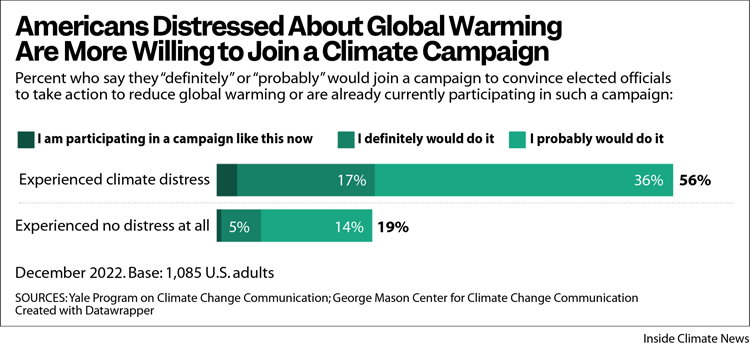
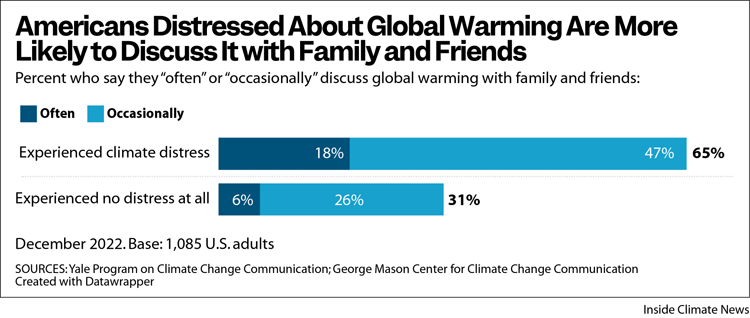
Yale researchers found that when compared to their white counterparts, Hispanic Americans were five times as likely to experience feelings of climate change anxiety and Black Americans were twice as likely to have those feelings. Overall, the study found, about 3 percent of Americans feel some form of climate change anxiety.
Nevertheless, researchers said, even though people of color and those with low incomes feel the outsized effects of eco-anxiety and climate-related trauma, many members of those communities do not receive the same level of resources and support as those who are white or have greater wealth.
Study after study after study has shown that people of color and those with lower incomes typically bear the brunt of environmental harms.
Analyzing Census data, the American Psychology Association found that 80 percent of American psychologists in the workforce are white.
That reality has led to creation of a wave of groups across the country who specifically serve people of color, among them the Alliance for Ecotherapy & Social Justice.
“A lot of that public attention to eco-anxiety focuses on middle class white people,” said Jade S. Sasser, an associate professor of gender and sexuality studies at the University of California, Riverside. “But the actual impacts of climate change in the United States fall hardest on low-income communities and communities of color.”
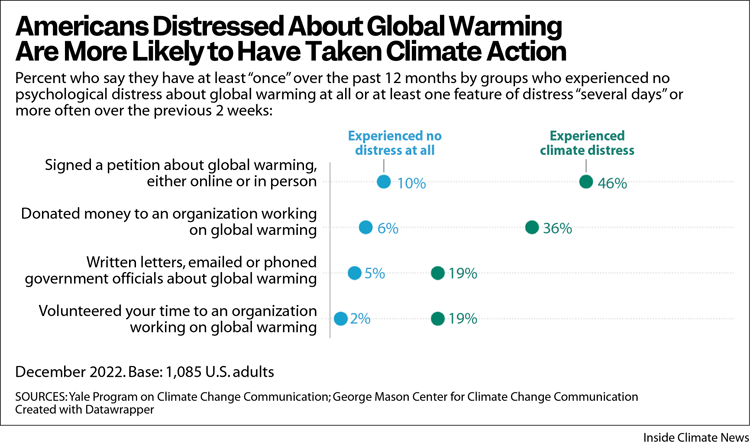
Sasser, who studies climate justice and reproductive politics, said that reality should compel those who are focused on public health and policy solutions about the issue to ensure that sufficient emphasis is placed on addressing the needs of the poor and of Black and brown people.
“To focus your eco-anxiety efforts on people who are not the most impacted is really unjust for those who really need the attention and the resources and the support,” Sasser said. “Eco-anxiety and eco-emotions—this is actually a climate justice issue. And when we put resources and attention and support to it, we need to prioritize those who are impacted the most—and that’s low-income communities of color.”
Navigating Trauma
In Philadelphia, at an event just before Earth Day last year called Healing the Land & Repairing Harm, Sonya Sanders watched herself in a video about the explosion that rocked the massive refinery in the summer of 2019, describing on film how she heard the sound and saw the flames and ran back to her home a few blocks away, where she found her husband, Ray, uninjured.
And suddenly it all came rushing back—she’s there running from the refinery, breathing the acrid smoke and polluted air that killed her husband and all the others from the neighborhood who’d died.
“So it brings all those feelings back,” she explained afterwards. “Ray’s just down the street, you know what I’m saying. The house is just down the street.”
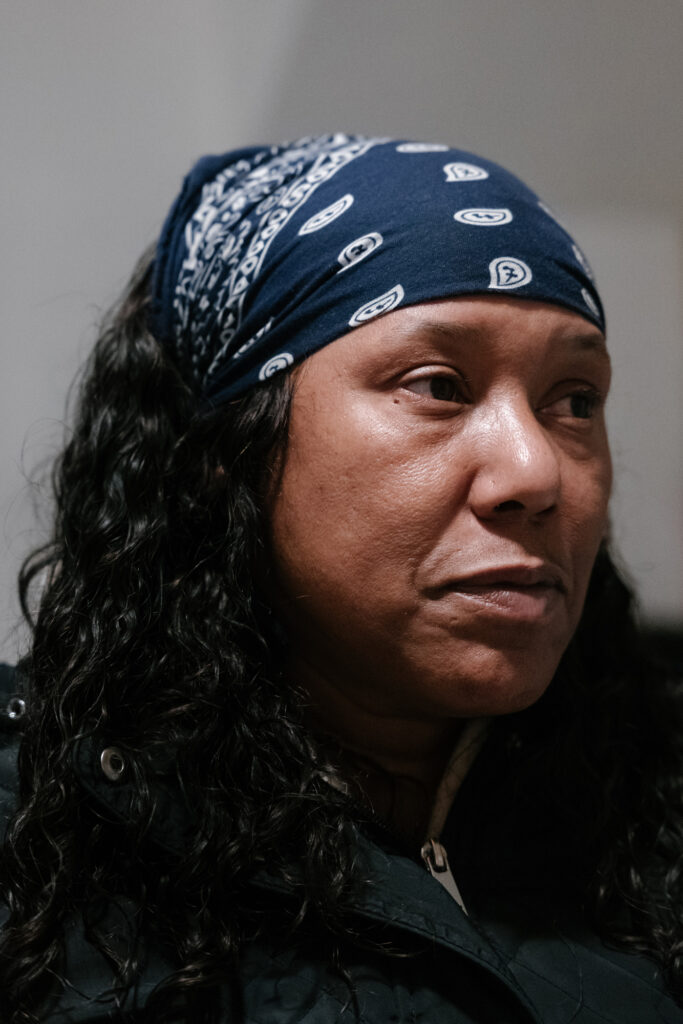
Only now, she’s able to deal with the panic, understand what’s happening, maintain her composure and keep her emotions to herself.
In many ways, Sanders is an outlier: Unlike other Black and brown people who are dealing with climate anxiety and post-traumatic stress, she was able to find help—and that help has given her the tools to navigate through her trauma.
Through therapy sessions and other treatment, she has been able to acknowledge the trauma she experienced growing up a few blocks away from the refinery and identify what triggers a stress reaction.
She found a Black therapist by asking other activists where she could go to get help. The costs of her sessions are covered by her insurance.
When Sanders talked about wanting to walk on the refinery site as part of a protest in the fall of 2022, her therapist did not discourage her. Sanders wasn’t sure if being on the soil of what she calls a “deadly land” would make her sick mentally and physically.
“It was scary when I went home because I felt like I had to kind of wash this dirty, nasty gritty place off of me,” said Sanders, who fears that pollution from the refinery made her husband and neighbors sick and drives much of her PTSD. “I felt like I was bringing that with me in my house, you know what I’m saying. I just wanted to clean the atmosphere.”
When the protest ended, Sanders went straight home, used a disinfectant spray all over her house, grabbed a towel to clean herself and put her clothes in the washing machine.
“Just to make sure I felt better,” said Sanders, who was later arrested after walking a mile at the former refinery. “I still could feel like I did something to try to fight against it. To protect my own house and my own family’s health.”
Sanders said her therapist later helped her work through her concerns. Finding new ways to deal with her anxiety is something Sanders works on daily. She said whenever she’s protesting, speaking to families or raising her fists in the air, she feels the presence of her husband and neighbors who died.
Therapy has also helped her find her voice in describing her trauma, and has also learned to trust herself when she decides not to use it—for example, keeping quiet about her husband’s death at events, like the video screening before Earth Day.
When the panic subsided and the moment had passed, she relaxed. “It feels good right now because I didn’t want to do it,” she said as she got ready to hand out reusable bags of organic cleaning products and fresh produce to neighborhood families, understanding that she was no longer a prisoner to such difficult emotions.
“When those spills come? You could smell all through the neighborhood, and in your house.”
In conversations over the past two years, Sanders has repeatedly said that she hopes by sharing her story, she can help others—that her experience might be instructive both for those who are living with climate-related trauma, and for the medical community as it develops new ways to treat others, especially people of color.
For Sanders, it sometimes feels as though she is reliving the slow-motion environmental disaster she endured as one of the refinery’s neighbors. She remembers the all-too-frequent accidental leaks and other mishaps at the old refinery.
“When those spills come? You could smell all through the neighborhood, and in your house,” she said. “It’s something like a gas smell, like it’s all in your house.”
Sanders said her family would cope during those episodes by gathering in a back room of their home and placing towels over the gap at the bottom of a closed door to keep the smell from coming inside.
“We wanted to protect ourselves,” she said, referring to herself, her husband and her son. “That was the main thing—the protection. But, to be honest with you, it didn’t do any good. He’s still dead.”
And even though Sanders has moved to another part of Philadelphia, miles beyond the reach of the now-closed refinery, she said she still keeps towels in a room in her new home—just in case.
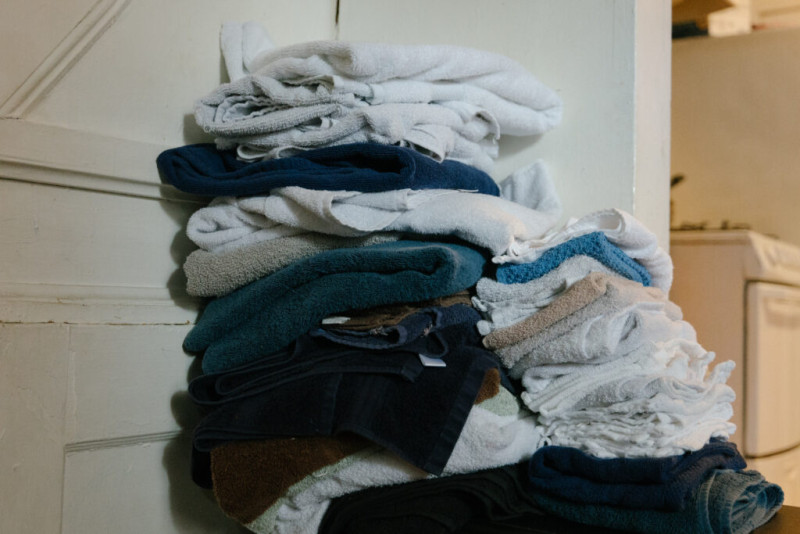
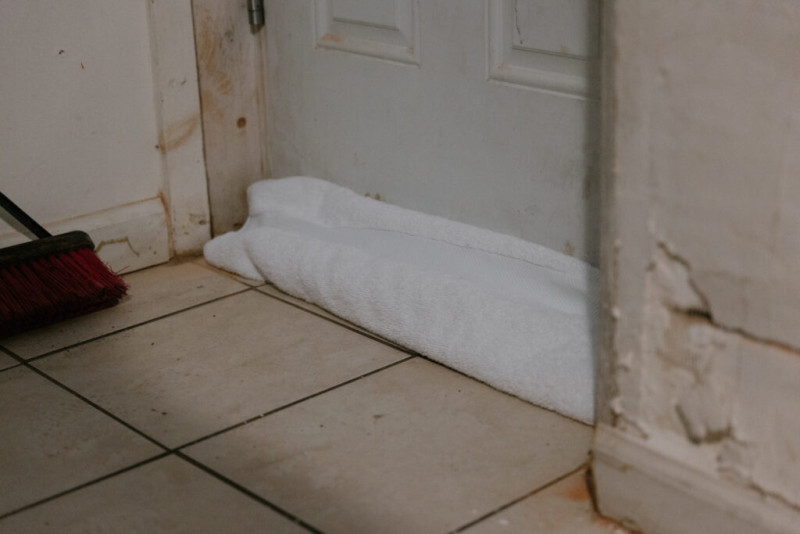
In addition to traditional counseling, Sanders said she also now finds solace in activism. She talks to voters on Election Day, she is usually one of the first to speak at meetings and rallies, and she marches in protests.
“I’m helping people, and trying to make a difference in the community,” she said as she headed to a meeting with residents to talk about asthma on Wednesday. “I don’t feel nervous, I don’t feel like something’s about to happen or I’m around something that’s going to kill me or I’m breathing in something bad. I just feel like I can help things change.”
For years, Sanders equated the emotional trauma that she is suffering strictly in terms of the noxious fumes from the refinery. But in recent months, particularly after she started working with a local climate activist group, Philly Thrive, she began to take a broader view of how her anxiety is exacerbated by concerns about climate change.
Her activism helps make her feel empowered and assuages some of her most anxious fears about the planet’s future. “It does help because I can visualize the future,” she said of her activism and her hopes that efforts to mitigate climate change will take hold in the years and decades to come.
“It brings peace to me,” she said.
Climate Change and Mental Health
Rebecca Burns Weston, a clinical social worker who specializes in working with those experiencing mental health issues related to climate change, has come to understand how that sense of peace can be essential for those dealing with eco-anxiety and the mental toll of a warming planet.
“Climate events themselves create trauma,” she said. “The consequences of climate change events themselves have huge implications for mental health and for social cohesion.”
Mitigating adverse mental effects and fostering greater cohesion is the goal for those like Weston, who are working to raise awareness about the correlation between concerns about climate change and adverse mental health effects.
Co-president of the Climate Psychology Alliance, Weston said she and her colleagues in the group are working to address “the inequitable impacts of climate change along racial lines, on economic lines, on gender lines.”
“The consequences of climate change events themselves have huge implications for mental health and for social cohesion.”
She referenced the aftermath of Hurricane Katrina in 2005 where “the follow up in terms of disaster response was so deeply racist and so deeply inequitable that the mental health impacts are also going to be solved inequitably.”
“What we’re trying to create is a network of climate-aware clinicians who can be in the community both doing one-on-one work, but also figuring out how to relate outside of the office space in a way that can provide care, can provide information, can speak to reporters so that, in fact, the climate, mental health issues can start looking much more nuanced,” said Weston. “So they’re not just labeled as a white people’s problem, because it’s not that.”
Ashlee Cunsolo is a researcher who works with Indigenous communities in Canada that are grappling with the mental health effects of climate change.
She noted that what researchers are seeing among those who are living with climate anxiety are hardly novel, even though the focus that’s being given to the topic is.
“It’s not a new phenomenon that people are emotionally and mentally connected to the environment,” said Cunsolo, a vice provost and dean at the Labrador campus of Memorial University in Newfoundland. “For thousands of years, people have had these connections and been very aware of how acutely important our external environment is to our internal health and well-being.”
“What is new and interesting is the speed at which the changes are happening, and the global and planetary reach of what’s happening around us,” she said. “And what that then means for people trying to find new phrases, new lexicons, new language that really identifies this critical moment in time that we’re at.”
Staying Alive
Grief, sadness, anger and anxiety are emotions all too familiar to Edward Buckles Jr. An African American filmmaker, he directed an HBO documentary called “Katrina Babies,” about the storm’s enduring effect on the young people who lived through it.
A New Orleans native, he was 13 when Hurricane Katrina struck in August 2005. He said he experiences a bit of anxiety each year as the anniversary approaches. He doesn’t call it eco-anxiety or PTSD, however, he prefers to say that he suffers from “climate racism.”
“Having the big conversation about climate change is always difficult for me because where I’m from, my experience and my family’s experience, we are still worried about the small things, like, if the hurricane comes, will there be enough transportation to get everybody out of the city,” said Buckles.
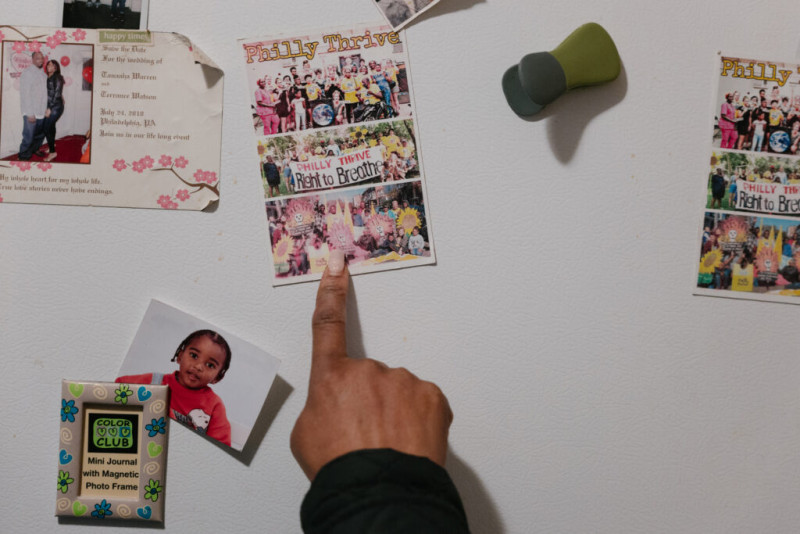
The 2022 anniversary of Katrina was particularly haunting, he said, because another storm, Hurricane Ida, made landfall in Louisiana that day. Ida would ultimately become the second most destructive storm in the state’s history, only after Katrina.
Buckles recalled commiserating with a fellow Katrina survivor after Ida rolled ashore.
“He was just telling me that he had this feeling of, like, surrealism because he was like, ‘Bro, I didn’t think that this would happen again during my lifetime,’” Buckles said. “This idea of us being stranded personally again. Like nobody is helping us again during another hurricane. It’s like didn’t you not learn the lesson the first time?
“So we’re still trying to wake people up—like, yo, I understand that this conversation about climate change is really important, but we’re still just trying to get the basic American rights, you know, like when it comes to dealing with it all.”
As the hurricanes get more extreme, he said, the wait for aid in the aftermath seems to take even longer in New Orleans’ low-income neighborhoods—if it comes at all—compounding the emotional despair and anxiety.
“It’s the resource allocation, it’s the racism, it’s understanding that no matter what happens with climate change, we’re going to be at the tail end of it and we’re not going to get the appropriate resources and the quick help,” Buckles said. “And because of that, that puts a different load on the actual people who are experiencing it. So, yes, it causes anxiety. But I also don’t have time to just get caught up in fear and anxiety because I have to make sure that my family and I survive.”
In Philadelphia, Sanders’ therapy and activism have enabled her to cope with the intense sense of loss she still experiences from the death of her husband. She visits their old neighborhood when she can, but she stays away, too.
“We just have to stay and do the fight,” she said. “There’s nothing you can run away from. You can keep running all you want, people are going to keep dying.”
When Sanders didn’t have any food for nearly a week in July and started searching for things to make for dinner at local food banks—it was another trigger for her PTSD.
She said she feels “locked away, discarded like trash. You know this brings it all that back.”
For Sanders, during those times, she said it feels like she never left her old home in South Philadelphia with her husband—worrying about the air.
“I’m back on 32nd Street. Fighting again just to live. Screaming for help. I am so broken and cracked up in so many pieces. Each piece is carrying so much pain.”
Someone at the food bank gave her soup and a meatloaf dinner that she shared with her son. When she spoke to a reporter that afternoon, she hoped that some bags of Doritos and the granola bars would hold them over until money wasn’t so tight. “We got lucky,” she said.
In a Facebook post last April, just a few days after the Earth Day event, Sanders created a video tribute to her late husband. She included a photo of him dressed in white with his arms folded, and she jotted down a short message to him:
My head held to the heavens screaming “I wanted you to know that you’re the one designed for me.” The tears will never stop flowing. My heart is forever broken.I love you with my soul. Always Sonya is broken, baby, until I walk through those gates.
She signed it with emojis of a broken heart and two angels.
Share this article
Disclaimer: The copyright of this article belongs to the original author. Reposting this article is solely for the purpose of information dissemination and does not constitute any investment advice. If there is any infringement, please contact us immediately. We will make corrections or deletions as necessary. Thank you.







